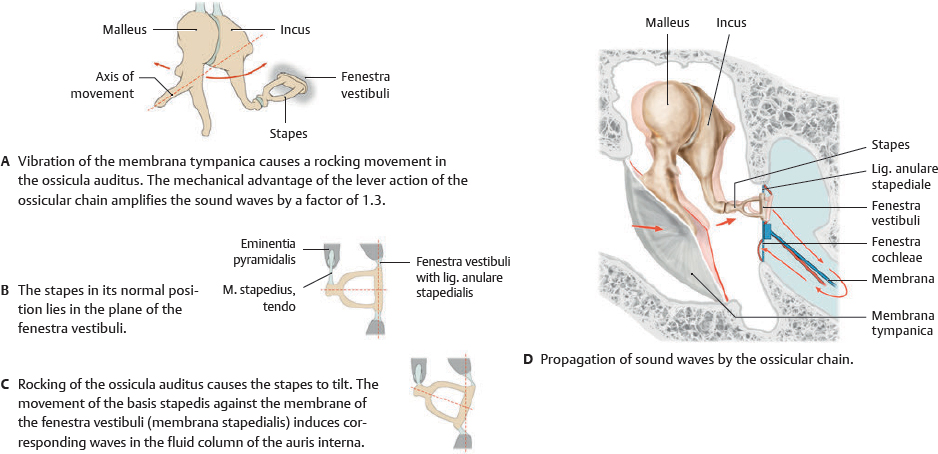Fig. 43.1 Os temporale
Left bone. The os temporale consists of three major parts: pars squamosa, pars petrosa, and pars tympanica (see Fig. 43.2).
Fig. 43.1 Os temporale
Left bone. The os temporale consists of three major parts: pars squamosa, pars petrosa, and pars tympanica (see Fig. 43.2).
Structures in the os temporale
The proc. mastoideus contains cellulae mastoideae that communicate with the auris media; the auris media in turn communicates with the pars nasalis pharyngis via the tuba auditiva (A). Bacteria may use this pathway to move from the pars nasalis pharyngis into the auris media. In severe cases, bacteria may pass from the cellulae mastoideae into the cavitas cranii, causing meningitis.

Irrigation of the meatus acusticus externus with warm (44°C) or cool (30°C) water can induce a thermal current in the endolympha of the canalis semicircularis, causing the patient to manifest vestibular nystagmus (jerky eye movements, vestibulo-ocular reflex). This caloric testing is important in the diagnosis of unexplained vertigo. The patient must be oriented so that the canalis semicircularis of interest lies in the vertical plane (C).

The pars petrosa of the os temporale contains the auris media and interna as well as the membrana tympanica. The bony canales semicirculares are oriented at an approximately 45-degree angle from the coronal, transverse, and sagittal planes (B).

 The auditory apparatus is divided into three main parts: auris externa, media, and interna. The auris externa and media are part of the sound conduction apparatus, and the auris interna is the actual organ of hearing (see p. 596). The auris interna also contains the vestibular apparatus, the organ of balance (see p. 596).
The auditory apparatus is divided into three main parts: auris externa, media, and interna. The auris externa and media are part of the sound conduction apparatus, and the auris interna is the actual organ of hearing (see p. 596). The auris interna also contains the vestibular apparatus, the organ of balance (see p. 596).
Curvature of the meatus acusticus externus
The meatus acusticus externus is most curved in its cartilaginous portion. When an otoscope is being inserted, the auricula should be pulled backward and upward so the speculum can be introduced into a straightened meatus.

Fig. 43.4 Meatus acusticus externus
Coronal section through right ear, anterior view. The membrana tympanica separates the meatus acusticus externus from the cavitas tympani (auris media). The outer third of the meatus acusticus externus is cartilaginous, and the inner two thirds are osseous (pars tympanica ossis temporalis).
Fig. 43.5 Structure of the auricula
The auricula of the ear encloses a cartilaginous framework that forms a funnel-shaped receptor for acoustic vibrations. The muscles of the auricula are considered mm. faciei, although they are vestigial in humans.
Fig. 43.8 Auris media
Right pars petrosa ossis temporalis, superior view. The cavitas tympani of the auris media communicates anteriorly with the pharynx via the tuba auditiva and posteriorly with the cellulae mastoideae.
Fig. 43.11 Ossicula auditus
Left ear. The ossicula auditus consists of three small bones that establish an articular connection between the membrana tympanica and the fenestra vestibuli.
Fig. 43.15 Membrana tympanica
Right membrana tympanica. The membrana tympanica is divided into four quadrants (I–IV).
Fig. 43.16 Ossicula auditus in the cavitas tympani
Lateral view of the right ear. Revealed: Ligaments of the ossicula auditus and muscles of the auris media (mm. stapedius and tensor tympani).
Ossicula auditus in hearing
Sound waves funneled into the meatus acusticus externus set the membrana tympanica into vibration. The ossicula auditus transmits the vibrations to the interna. Sound waves in fluid meet with higher impedance; they must therefore fenestra vestibuli, which communicates them to the fluid column of the auris be amplified in the auris media. The difference in surface area between the membrana tympanica and the fenestra vestibuli increases the sound pressure 17-fold. A total amplification factor of 22 is achieved through the lever action of the ossicular chain. If the ossicula auditus fails to transform the sound pressure between the membrana tympanica and the basis stapedis, the patient will experience conductive hearing loss of magnitude 20 dB.


Fig. 43.17 Artery of the auris media: Ossicula auditus and membrana tympanica
Medial view of the membrana tympanica. With inflammation, the artery of the membrana tympanica may become so dilated that their course can be observed (as shown here).
Fig. 43.18 Arteries of the auris media: Cavitas tympani
Right pars petrosa ossis temporalis, anterior view. Removed: Malleus, incus, portions of chorda tympani, and a. tympanica anterior.
 The auris interna consists of the vestibular apparatus (for balance) and the auditory apparatus (for hearing). Both are formed by a labyrinthus membranaceus filled with endolympha floating within a labyrinthus osseus filled with perilympha and embedded in the pars petrosa ossis temporalis.
The auris interna consists of the vestibular apparatus (for balance) and the auditory apparatus (for hearing). Both are formed by a labyrinthus membranaceus filled with endolympha floating within a labyrinthus osseus filled with perilympha and embedded in the pars petrosa ossis temporalis.
Fig. 43.20 Auditory apparatus
The labyrinthus cochlearis and its bony shell form the cochlea, which contains the sensory epithelium of the auditory apparatus (organum spirale).
Fig. 43.21 Innervation of the labyrinthus membranaceus
Right ear, anterior view. The n. vestibulocochlearis (CN VIII; see p. 536) transmits afferent impulses from the auris interna to the truncus encephali through the meatus acusticus internus. The n. vestibulocochle- aris is divided into the n. vestibularis and n. cochlearis. Note: The sensory organs in the canales semicirculares respond to angular acceleration, and the macular organs respond to horizontal and vertical linear acceleration.
Fig. 43.22 Blood vessels of the auris media
Right anterior view. The labyrinthus receives its blood supply from the a. labyrinthi, a branch of the a. inferior anterior cerebelli (see p. 674).